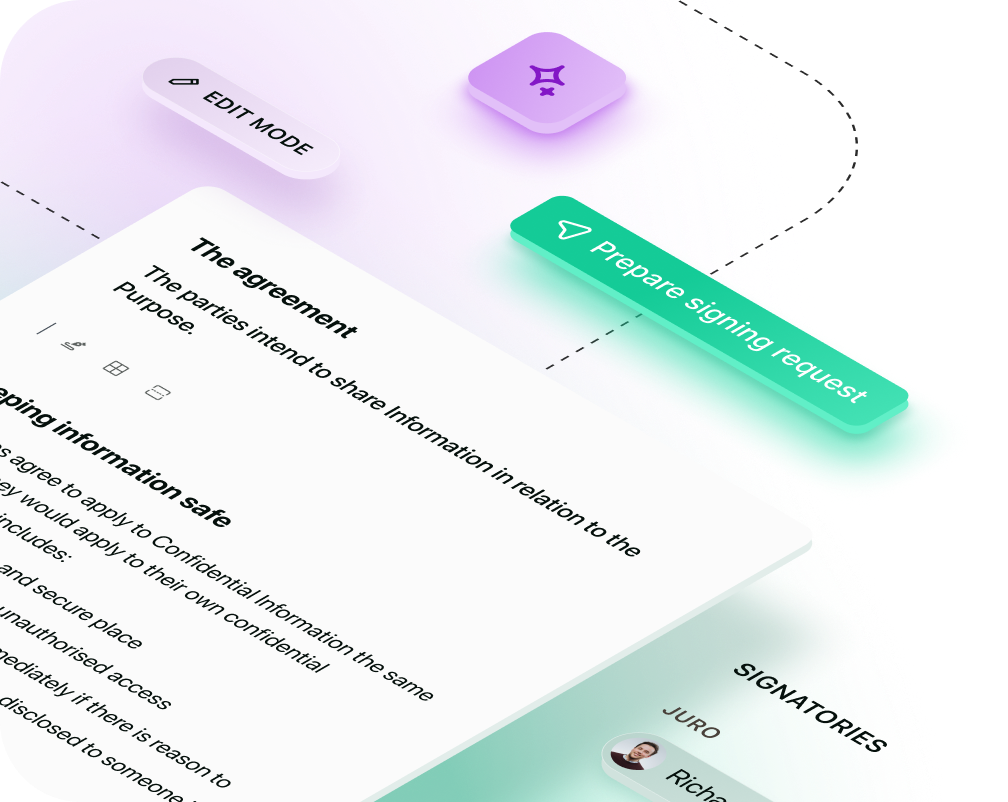Solutions
Customer Support
Resources
Having a comprehensive apprenticeship agreement template in place is a great way to reduce time-to-hire. Download your free apprenticeship agreement template today.




There are lots of formalities to consider when hiring a new apprentice to join your team. One of these is creating, agreeing and signing an apprenticeship agreement.
In this guide, we'll explore what an apprenticeship agreement is, what it covers, and how to automate them in Juro. Get started today by downloading our free apprenticeship agreement template.
An apprenticeship is a structured training program that combines on-the-job learning with classroom instruction to prepare individuals for a specific trade or profession.
Apprentices work under the guidance of experienced mentors, gaining practical skills and knowledge while still earning a wage.

They're increasingly common in practical industries like construction and manufacturing, but there's an increasing trend across the globe whereby apprenticeships are offered for corporate roles, too.
In fact, data from Apprenticeship.gov suggests that the number of apprentices in the US has jumped from 359,788 to 679,960 in the last nine years.
UK apprenticeship data tells a similar story, with steady increase in apprenticeship starts in 2024.
An apprenticeship agreement is a legally binding contract between an apprentice and an employer, detailing the rights and responsibilities of both parties.
Just like an employment contract, an apprenticeship agreement defines the scope of the apprentice's role, the training they will receive, and the employer's expectations, among other things.

Getting the apprenticeship agreement form right is crucial for a successful apprenticeship experience. It not only clarifies the obligations of both parties but also sets clear expectations.
Here are three reasons why your business needs a clear, concise and well-structured apprenticeship agreement.
In many jurisdictions, apprenticeship agreements are a legal requirement. They provide the basis for any legal disputes that may arise between the apprentice and the employer.
The agreement sets out the expectations for both the apprentice and the employer. It defines the work the apprentice does, their training and how their progress will be monitored and evaluated.
A well-crafted apprenticeship agreement ensures that both parties know what to expect from each other. This prevents misunderstandings and ensure a smoother, more productive working relationship.
There are a few key differences between an apprenticeship agreement and a broader, general employment contract. You should be aware of these before creating or signing one:
Usually, the talent team (HR team) will be responsible for creating and managing apprenticeship agreements. However, they may occasionally need legal teams to review the contract's terms, especially if these vary following negotiations.
.avif)
Apprenticeship agreement templates will vary depending on the nature of work the apprentice will be undertaking. However, most apprenticeship agreements will cover the following elements:
The agreement should clearly define the role of the apprentice, the type of work they will be expected to perform and the results they should achieve.
The agreement should outline the training the apprentice will receive, including who will provide it, the duration, and any qualifications or certifications that may result from the training.
Working hours and leave entitlements must also be included. This section should explain the apprentice’s working hours, rest breaks, and holiday allowances, ensuring that their rights are protected and that the agreement complies with labor laws.
Policies and procedures, such as workplace rules, health and safety standards, and codes of conduct, should also be outlined in an apprenticeship contract to provide clarity on what is expected in the workplace.
Wages or payment details are another critical element of the agreement. These should outline how much the apprentice will be paid and how often, ensuring fair compensation and transparency from the outset.
The apprenticeship agreement template should detail how the apprentice's performance will be assessed and monitored, including details about regular check-ins, progress reports, and feedback sessions. This helps to provide clarity on what good performance is and how to maintain those standards.
Managing apprenticeship agreements can become a drag for legal and HR teams with no automation or templates in place. This is particularly true for those organisations that hire apprentices at scale in seasonal sprints.
Businesses that hire and onboard apprentices at scale will need to draft and populate contracts one by one, manually inputting all of the apprentice's data.
This manual nature of this process can result in wasted time, miscommunication, and a lengthy time-to-hire.
.avif)
The process of issuing and signing apprenticeship contracts to new joiners becomes much more manageable with a comprehensive apprenticeship agreement template to hand. It's even faster and more efficient if you host this apprenticeship agreement template in Juro.
Instead of creating contracts from the ground up, businesses can store their apprenticeship agreement templates in Juro's AI-enabled contract management tool, enabling them to generate apprenticeship agreements 10x faster than with traditional tools.
When HR teams have apprenticeship agreements set up as automated templates in Juro, they can streamline these contracts.
Teams initiate a contract from the pre-approved template, these templates are then automatically filled using a straightforward Q&A workflow. Templates can also be filled by pulling contract data from an applicant tracking system (ATS) like Greenhouse and BambooHR.
Juro's bulk actions even enable HR teams to generate, send and sign apprenticeship agreements at scale.
Juro is the ideal solution for fast-growing companies that hire candidates in bulk and need to self-serve on contracts with confidence.
Juro's flexible contract management platform can be used to safely automate up to 75% of contract admin tasks. This makes creating and managing apprenticeship agreements a breeze for HR teams.
To find out more about Juro's rich feature set and how it can enable your business to reduce time-to-hire, hit the button below.
Like this apprenticeship agreement example? Grab our other popular employment contract templates:
Juro is the #1-rated contract platform globally for speed of implementation.


Juro embeds contracting in the tools business teams use every day, so they can agree and manage contracts end-to-end - while legal stays in control.
Book your demo